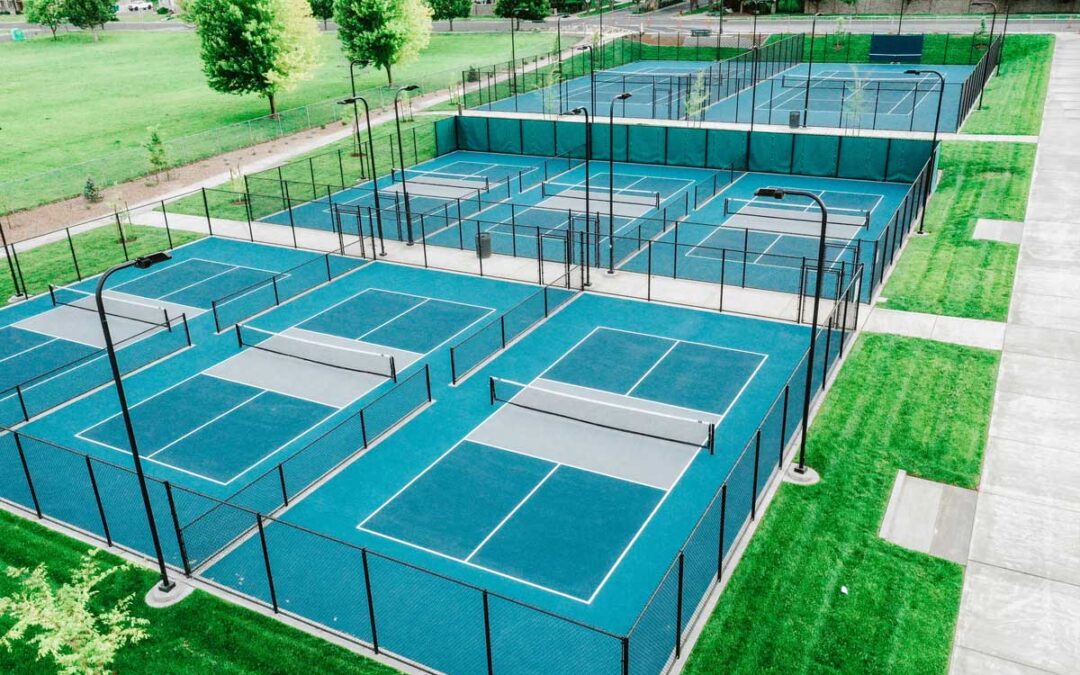As pickleball continues to gain popularity across the United States, many tennis court owners are exploring the possibility of converting their existing courts to accommodate this exciting sport. If you have a tennis court and are considering making the switch, this guide will help you understand the steps involved, the benefits of multi-sport functionality, and key considerations for resurfacing and marking the court appropriately.
Steps to Convert a Tennis Court to Accommodate Pickleball
Converting a tennis court to a pickleball court can be a straightforward process if you follow these steps:
- Assess Your Court: Start by evaluating the condition of your existing tennis court. Check for cracks, surface wear, and overall integrity. Address any necessary repairs before proceeding with the conversion.
- Dimensions and Layout: A standard pickleball court measures 20 feet wide by 44 feet long for doubles play, with a 14-foot non-volley zone (also known as the “kitchen”) extending 7 feet from the net on each side. The tennis court’s dimensions are 36 feet wide by 78 feet long for doubles, allowing ample space for multiple pickleball courts to fit within the same area. Depending on your available space, you can set up one or two pickleball courts on a single tennis court.
- Marking the Court: Once you have determined the layout, you will need to mark the new lines. You can use removable court tape or paint to outline the pickleball court dimensions, including the sidelines, baselines, and the non-volley zone. Ensure that the markings are clear and comply with the official rules for pickleball.
- Resurfacing the Court: Depending on the condition of your existing surface, you may want to consider resurfacing the court to create a smooth, even playing area. This can enhance the playability for both tennis and pickleball. Choose a surface material that is suitable for both sports, such as acrylic or a similar hard court material.
- Installing a New Net: The net height for pickleball is slightly lower than for tennis. You’ll need to install a net that meets the official pickleball specifications, which is 36 inches high at the ends and 34 inches high in the middle.
Benefits of Multi-Sport Functionality
One of the most significant advantages of converting your tennis court to accommodate pickleball is the ability to utilize the space for multiple sports. Here are some benefits of multi-sport functionality:
- Increased Usage: With the growing popularity of pickleball, offering this sport on your court allows for more players to enjoy the facilities. This can lead to increased usage and enjoyment of your court throughout the year.
- Community Engagement: Multi-sport courts can foster a sense of community by bringing together tennis and pickleball players. Hosting events, clinics, or social games can create an inclusive environment for all skill levels.
- Enhanced Property Value: A versatile court that accommodates multiple sports can enhance the value of your property. Potential buyers often look for features that provide additional recreational options.
Considerations for Resurfacing and Marking the Court
When converting your tennis court to a pickleball court, several factors should be considered for resurfacing and marking:
- Surface Condition: Ensure that the court is in good condition before applying any new surfaces. Resurfacing can be a cost-effective solution to improve playability.
- Color Choices: Choose colors for the new markings that contrast well with the existing court color, making it easy for players to see the lines.
- Long-lasting Materials: Use durable materials for both resurfacing and court markings to withstand wear and tear from frequent use.
Cost and Time Estimates for Conversion
When comparing the cost and time estimates for converting an existing tennis court versus building a new pickleball court, here’s what you need to know:
- Cost of Conversion: Converting a tennis court to a pickleball court typically varies depending on the required resurfacing, new net installation, and marking materials. This is significantly less than the cost of constructing a new pickleball court.
- Time Frame: The conversion process can be completed in a shorter time frame then a new court, depending on the extent of resurfacing and weather conditions. In contrast, building a new court can take several weeks to months, considering permits and construction timelines.
Conclusion
Converting your tennis court to accommodate pickleball is a smart move that offers numerous benefits, including increased usage, enhanced property value, and the opportunity for community engagement. By following the outlined steps for conversion, you can create a versatile sports space that caters to the growing demand for pickleball.
If you’re ready to take the next step in converting your tennis court or have questions about the process, CALL 800-558-3664 today for your free, no-obligation quote. Let Taylor Tennis Courts help you transform your court into a multi-sport facility that everyone can enjoy!


Recent Comments